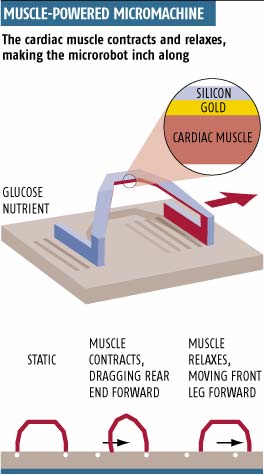A micro robot, made of silicon and half the width of a human hair, began to crawl in a laboratory in Los Angeles. He did so with the help of his legs, which are driven by the beating of a heart muscle. This is the first time that muscle tissue has driven a micro machine.

A micro robot, made of silicon and half the width of a human hair, began to crawl in a laboratory in Los Angeles. He did so with the help of his legs, which are driven by the beating of a heart muscle. This is the first time that muscle tissue has driven a micro machine.
The innovative development may lead to nerve stimulation devices based on muscle tissue, which will allow people suffering from paralysis to breathe without the help of a ventilator. In addition, NASA, which is funding the research, hopes that masses of reptilian "robo-muscles" will be able to help maintain spacecraft in the future by plugging holes in the spacecraft's body, which are created following the impact of micrometeorites.
Regardless of how this technology might be used, no one would be more surprised to see the tiny robomuscles being more comfortable than Carlo Montemagno, the microengineer whose team is developing the tiny robots at the University of California, Los Angeles.
Montemagno spent three tedious years trying to harness living muscle tissue to power micro-machines and failed time and time again. However, when he and his team looked into their microscopes, they were amazed to see the latest version of the robot crawling around.
The robot is built from a silicon arc 50 micrometers wide. The team grew a string, made of cardiac muscle fibers, and attached it to the lower part of the bow (see illustration). The contraction and relaxation movements of the heart tissue cause the arch to curve and stretch to create the crawling motion. The muscle tissue is fed simple glucose from a petri dish.
The possibility of using muscles to drive micro electromechanical systems (MEMS - Micro Electro Mechanic Systems) is an interesting alternative to micro motors. While engines need electricity to run, muscles consume glucose as an energy source. The glucose can be spread on the surfaces on which the robot will work, thus guaranteeing it an available source of energy.
The breakthrough in the work of the team from UCLA (University of California) lies in the development of an automatic way to attach muscle tissue to a material such as silicone. The team designed a basic arch-shaped skeleton out of silicon. He did this using automated microchip manufacturing equipment, and then the team coated the bow with an etchable polymer.
The next step was to remove the coating on the inside of the arch and replace it with gold leaf. The purpose of the replacement is to provide support for the muscle cells, which will be located there. To grow the muscle, the bow was placed in a Petri dish, which contained rat heart muscle cells in a glucose medium. Over the course of three days, the muscle cells grew, and muscle fibers developed, which adhered to the gold on the arch and formed a cord of heart muscle along the arch.
During the process of cell growth, the bow was held with a kind of beam, which limited the movement of the bow. When the beam was removed, the robot immediately began to crawl at a speed of up to about forty micrometers per second. The geometry of the robot ensures that its contraction will push it in one direction and that it will not simply contract and let go without moving.
Now Montemagno intends to use the technology to help sufferers with damaged diaphragmatic nerves. These nerves send stimuli to the diaphragm, which allows us to breathe. Those suffering from damage to these nerves are often dependent on a ventilator to breathe.
Instead of moving the robomuscle, the muscle fibers will cause a piece of piezoelectric material to bend, which will produce a voltage of several millivolts, which will stimulate the diaphragm nerves. The facility will use the patient's own heart cells, thus preventing a situation of transplant rejection. The muscle will also receive energy from the glucose in the blood.
Initially, the Institute for Advanced Ideas of NASA said that it should design a micromachine, driven by muscles, that could search for and repair holes in the body of a spacecraft, which are created by the impact of micrometeorites.
Montemagno emphasizes that such uses are still decades away from implementation. "We haven't even begun to address the issue of communication between the microrobots themselves," he says. It is also not clear where exactly they will get energy from. Be warned, you may be hearing about a sugar-coated spaceship soon.
